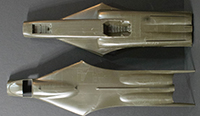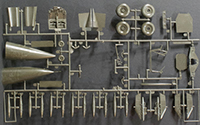
Monogram 1/48 F-111A Kit First Look
By Michael Benolkin
| Date of Review | June 2017 | Manufacturer | Monogram |
|---|---|---|---|
| Subject | F-111A | Scale | 1/48 |
| Kit Number | 5804 | Primary Media | Styrene |
| Pros | Simple build | Cons | See text |
| Skill Level | Experienced | MSRP (USD) | OOP |
First Look
 |
 |
 |
 |
The F-111 (TFX) program is a textbook example for what happens with poor requirements management. While the US Air Force was looking for their next generation fighter-bomber to replace the F-105, the Navy was looking for a fleet defense fighter to replace the F-4 Phantom II and F-8 Crusader. Then-Secretary of Defense Robert McNamara insisted that the USAF and USN combine forces to buy a common platform to save money. Unfortunately, his DoD staff failed to oversee the two services, and the USAF and USN put so many service-specific requirements for their aircraft that it became impossible to meet the needs of either service with a common airframe. The F-111B (fleet defense) was a failure (as intended) and the F-111A nearly followed suit. In the F-111A's combat debut, three aircraft were lost to what was reportedly wing failure and the aircraft was withdrawn for further investigation. Even though the F-111 was the worlds first production swing-wing aircraft, critics insisted that the concept was flawed and should be cancelled. Nevertheless, the three losses in Southeast Asia were found to be stabilator malfunctions which were fixed and the F-111A returned to service.
As a variable geometry winged aircraft, the F-111 had excellent low-speed and take-off/landing performance with the wings swept forward and even better high-speed performace with the wings swept aft. While an F-15E will bounce around in turbulance at low-altitudes, the F-111 could ingress and egress a target area with a smooth ride due to its high wing-loading at full aft sweep. In addition to its internal weapons bay, the F-111 had four pylons that pivoted with the wings to keep its external loads aimed along the line of flight, and another four pylons that were fixed to the cruise sweep angle for external tanks (when needed). The nose housed a revolutionary terrain-following radar that allowed the aircraft to automatically fly at a designated height above the ground. The crew sat side-by-side in a capsule that could be rocketed away from the aircraft at supersonic speeds to parachute the crew safely to the ground in an emergency.
Here is another old 'classic' kit from Monogram, the F-111A in 1/48 scale. Unlike many of the other excellently engineered and detailed kits by this company including the rest of the 'Century' series, this kit is nothing more than a budget shortcut. Before this kit was first released, the only kit of the F-111 'out there' was the venerable Aurora kit which had numerous detail issues. To paraphrase 'Bondo' Phil Brandt who used to fly in the F-111A, the Aurora kit was a 'stand-off' scale model of the aircraft. When Monogram decided to add the F-111A to their catalog, rather than designing it properly, they simply used the Aurora tooling. The result was less than stellar, but the model still looks like an F-111A from across the room.
This particular release was a reissue done under the banner of an ABC TV series 'Call To Glory' that aired in 1984-85. Several other kits were also released under this banner and can be seen at kit swaps even though some of the subjects, like this F-111A, were never featured in the series. This kit is molded in olive green styrene and presented on a few parts trees plus a number of loosely added parts like the wing halves, fuselage halves, etc.
Because this is an Aurora kit, it will require some skills and tools to fit and fill the awful seams. If you do build the kit, be sure to add ballast to the nose as it will sit on its tail with the wings swept full aft.
This kit will build into a reasonable model which makes it a good (and inexpensive) candidate for a project to learn more advanced modeling skills. These kits are inexpensive at kit swaps and make good projects for those who are afraid of messing up a good kit (and if you want a good laugh, look at the so-called collector prices for this kit on eBay). If you want a good kit of the F-111, look for an Academy kit instead.







